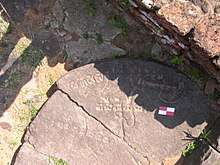The South Asia Inscriptions Database
Siddham or the Asia Inscriptions Database is an open-access resource for the study of inscriptions from South, Central and South East Asia. Siddham was established by the European Research Council with start-up funding from the project Beyond Boundaries: Religion, Region, Language and the State. The first focus of Siddham is Sanskrit epigraphy, mainly of the fourth, fifth and sixth centuries CE, but the platform is designed to accommodate inscriptions from all periods. In South Asia alone, the estimated number of historic inscriptions is 90,000.[1] In its next phases, Siddham will expand to include inscriptions in Tamil, Kannada, Prakrit, Tibetan, Burmese, Pyu and Mon.


Etymology
In Sanskrit siddhaṃ means "success, accomplished, perfected." It was also symbolism and substitution for an "auspicious sign" found in the oldest inscriptions of the South Asia. In some cases, siddham is not spelled out, but indicated with a sign such as Om or a srivasta, and various scholars consider siddham in inscriptions to be equivalent to these signs.[2][3]
This word, written out in characters (such as those shown in the Siddham logo) or represented by a symbol, often stands at the beginning of inscriptions in Indic languages.[2] The term Siddham is also used as a short name for the Indian script known as siddhamātṛkā.
Technical background
Some of the records in Siddham have been prepared in EpiDoc, a tool for structured markup of epigraphic documents in TEI XML. Other records are presented as simple text documents.
Numbering system
Within Siddham, each item is listed firstly as an object -- such as a pillar, sculpture, copper-plate, stone slab and so forth. Each object may carry one or more inscriptions, thus each inscription has been assigned a separate Siddham number. A good example is the Allahabad pillar -- a single object -- which carries many inscriptions, among them those of Aśoka, Samudragupta and Jahāngīr.[4] The inscription of Samudragupta appears in Siddham as IN00001.[5] All material generated for SIDDHAṂ is archived in Zenodo.
The further example illustrated here is from Salihundam, Gara Mandal, Srikakulam district, Andhra Pradesh, India, a Buddhist place located approximately at 18°20'7"N 84°2'28"E. At this site, a series of five votive inscriptions are engraved on the semi-circular threshold of a ruined shrine. In Siddham, the semi-circular stone will carry an object number and each votive record an independent inscription number. The photograph of the inscriptions is archived as Zenodo. http://doi.org/10.5281/zenodo.557032.


Translations
Translations of inscription texts into western languages are given in the website where available. They are archived separately in the community called SIDDHAṂ traductions in Zenodo.
Mapping
Epigraphic documentation involves mapping the sites where inscriptions were found. The mapping data is added in the appropriate section of the 'tool box' for each record.
References
- Salomon, Richard. Indian Epigraphy: A Guide to the Study of Inscriptions in Sanskrit, Prakrit, and the Other Indo-Aryan Languages. New York: Oxford University Press, 1998.
- Richard Salomon (1998). Indian Epigraphy: A Guide to the Study of Inscriptions in Sanskrit, Prakrit, and the other Indo-Aryan Languages. Oxford University Press. pp. 67–68. ISBN 978-0-19-535666-3.
- Lore Sander (1986), Om or Siddham–Remarks on Openings of Buddhist Manuscripts and Inscriptions from Gilgit and Central Asia, in Deyadharma: Studies in Memory of Dr. DC Sircar, pages 251-261
- Falk, Harry. Aśokan Sites and Artefacts: A Source-Book with Bibliography. Mainz am Rhein: Ph. von Zabern, 2006.
- See: http://siddham.uk/object/ob00001